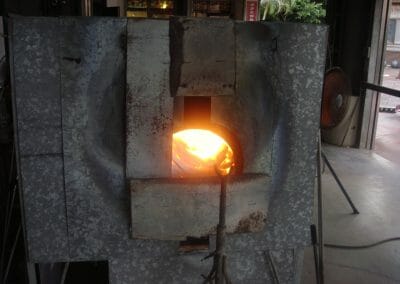Create your own beautiful glass piece to take home while admiring the stunning Ryukyu glass, a relatively new craft in Okinawa, compared to bingata dying and ceramics. Craftsmen in Okinawa began making colorless glass items for everyday use such as oil vessels and fly catchers at the beginning of the 20th century.
The post-WWII American presence in Okinawa influenced the trade in two ways. Firstly, the local craftsmen melted down and transformed Coke, 7-up, and beer bottles discarded by the Americans into glassware with hints of blue, green, and brown. Secondly, the Americans stationed in Okinawa became fascinated with the handmade glass’s beauty and began requesting a broader range of glass items for entertaining and décor. Punch bowl sets, decanters, and colorful flowers were in high demand, and Ryukyu glass quickly became a popular souvenir for tourists.
You can visit the Ryukyu Glass Craft Center in Itoman, the largest glass workshop in Okinawa, and enjoy its shops, museum, and outdoor workshop for free. The colorful glass mosaic pillars and murals adorn the main building, while the foyer’s ceiling features a rainbow-colored stained glass window.
The museum, situated in the back next to the outlet shop, boasts luminous glass pieces that are both massive and dainty, stylized, and utilitarian. You can see a glass sanshin, the Okinawan banjo, majestically displayed on one table. Some shelves showcase colorless fly catchers and medicine jars from the early 1900s. Contemporary artists’ pieces are also available for purchase, but unfortunately, photography is not allowed in the museum.
The outdoor workshop is where all the magic happens. Craftsmen melt down glass and blow it into molds or free-style. With the help of skilled workers, you can create your own piece, such as a tumbler, starting at ¥1500. The finished piece will require three days to cool before you can take it home.
One of the highlights of visiting the Ryukyu Glass Craft Center is browsing the various types and colors of handmade glass for sale. Each piece undergoes careful inspection, and if there is a small mark that does not meet the standard, the item is sold at a steep discount, with a sticker next to the blemish to notify customers. These marks are often hardly noticeable, making these pieces ideal gifts or additions to your collection, and they offer exceptional value for money.



